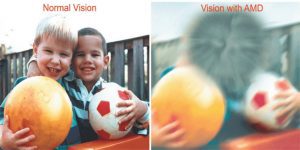 Age-Related Macular Degeneration (AMD) poses a growing threat to the aging population, casting shadows on the clarity of vision and altering the landscape of countless lives. This degenerative eye condition, affecting the macula – the central part of the retina responsible for sharp, detailed vision – demands our attention and understanding as we explore its intricacies and potential avenues for intervention.
Age-Related Macular Degeneration (AMD) poses a growing threat to the aging population, casting shadows on the clarity of vision and altering the landscape of countless lives. This degenerative eye condition, affecting the macula – the central part of the retina responsible for sharp, detailed vision – demands our attention and understanding as we explore its intricacies and potential avenues for intervention.
The Silent Onset: Unveiling the Progression of AMD
AMD often begins its subtle assault without overt symptoms, leading to a silent progression that catches many by surprise. As we age, the cellular structure of the macula undergoes changes, contributing to the onset of AMD. Two main types, dry AMD and wet AMD, present distinct challenges. Dry AMD typically advances slowly, marked by the accumulation of drusen, small yellow deposits beneath the retina. In contrast, wet AMD involves abnormal blood vessel growth beneath the macula, leading to faster and more severe vision loss.
The Aging Factor: Unraveling the Demographics of AMD
Understanding the demographics of AMD reveals a stark reality – this condition predominantly affects the elderly. As our global population ages, the prevalence of AMD is on the rise, with individuals over the age of 50 facing an increased risk. Environmental factors, genetics, and lifestyle choices contribute to this complex interplay, underscoring the importance of a multifaceted approach to tackle the root causes of AMD.
The Battle for Sight: Current Treatment Landscape
While a complete cure for AMD remains elusive, advancements in research and medical technology offer hope for managing the condition. Treatments vary based on the type of AMD diagnosed. Anti-VEGF medications, injections that inhibit abnormal blood vessel growth, have become a cornerstone in managing wet AMD. Additionally, lifestyle modifications, including a diet rich in antioxidants and protective eyewear, play a crucial role in mitigating the progression of AMD.
The Role of Genetics: Unveiling the Genetic Puzzle of AMD
mining an individual’s susceptibility to AMD. Identifying specific genetic markers associated with AMD enables a more personalized and targeted approach to diagnosis and treatment. As the field of genetic research expands, it opens new avenues for precision medicine, offering tailored interventions based on an individual’s unique genetic makeup.
Breaking Barriers: Emerging Technologies in AMD Research
Cutting-edge technologies are reshaping the landscape of AMD research and treatment. Artificial intelligence (AI) is making strides in early detection through the analysis of retinal images, providing a faster and more accurate diagnosis. Stem cell therapy and gene editing techniques are also emerging as promising frontiers, offering potential avenues to restore damaged retinal tissue and address the root causes of AMD.
Vision for the Future: A Call to Action Against AMD
The fight against AMD extends beyond the realms of medicine and science – it calls for a collective effort to raise awareness, promote early detection, and support research initiatives. By fostering a culture of eye health and advocating for regular eye check-ups, we can collectively contribute to the prevention and early intervention of AMD, ensuring a clearer and brighter future for generations to come.
In conclusion, Age-Related Macular Degeneration casts a significant shadow on the aging population, affecting millions worldwide. As we unravel the complexities of AMD, from its silent onset to the forefront of genetic research and emerging technologies, the imperative is clear – to confront this condition head-on, armed with knowledge, awareness, and a united commitment to preserving the gift of sight.
BRADLEY MIDDAUGH, O.D.
Optometric Physician
Dr. Bradley Middaugh is a boardcertified optometric physician committed to providing his patients the highest level of care through innovative technology and a focus on providing an excellent patient experience. Dr. Middaugh has extensive training in ocular disease, vision testing, eyewear prescriptions, specialty contact lenses and the diagnosis and treatment of eye disorders for patients of all ages, from pediatric to geriatric.
Dr. Middaugh graduated from Wake Forest University and earned his doctorate at The University of Alabama at Birmingham. He has been in private practice since 1988 and founded The Fort Myers Eye Center in 1993. In 2020, he joined the Center For Sight team to offer his patients direct access to the some of the finest cataract, LASIK, glaucoma, cornea, retina, and oculo-plastics specialists in Southwest Florida.
Dr. Middaugh has served on the Lee County School Board as a member of the Health Care Advisory Panel and the Early Intervention Health Care Panel. He is also an active member of the Southwest Florida Optometric Association, the Florida Optometric Association, and the American Optometric Association, and Above Board Chamber. In addition, he enjoys leading Medical Mission teams annually to El Salvador.
Dr. Middaugh and his wife, Meg, enjoy raising their two boys. The family is very active in their church, Walk to Emmaus, Kairos Prison Ministry, and enjoy serving on medical mission teams.
Center for Sight
239-310-2020
www.centerforsightswfl.com
1537 Brantley Rd, Fort Myers, FL 33907









